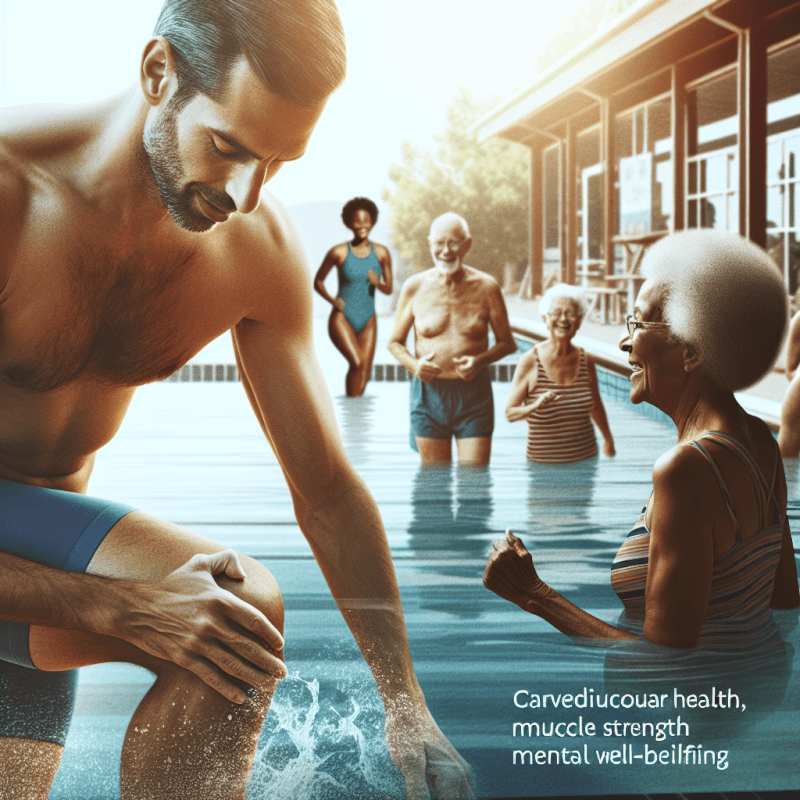As you or your loved ones age, it is vital to prioritize maintaining a healthy and active lifestyle. One activity that offers a plethora of benefits for older adults is swimming. Not only does it provide a refreshing escape from the summer heat, but swimming also offers numerous advantages for the aging population. From improving cardiovascular health to promoting joint flexibility, swimming is a low-impact exercise that can enhance physical strength and mental well-being, ensuring a higher quality of life as you embrace the golden years.

Physical Benefits
Swimming offers a range of physical benefits that can greatly improve the overall health and well-being of older adults. First and foremost, swimming is an excellent way to improve cardiovascular health. As you glide through the water, your heart rate increases, promoting blood circulation and strengthening your heart muscles. Regular swimming can reduce the risk of heart disease, high blood pressure, and strokes.
In addition to cardiovascular health, swimming also helps to increase muscular strength and endurance. The water provides a natural resistance that challenges your muscles as you swim. This resistance not only helps to build and tone your muscles, but it also improves your overall endurance. With regular swimming, you’ll find that you are able to swim longer distances and complete more challenging workouts.
Another notable benefit of swimming is its ability to enhance flexibility and joint mobility. In the water, your body is supported by buoyancy, which reduces the impact on your joints. This allows for a wider range of motion and helps to improve flexibility. The gentle, fluid movements of swimming also contribute to increased joint mobility, making it a great exercise option for older adults who may have arthritis or other joint conditions.
Weight management is another significant physical benefit of swimming. Engaging in regular swimming workouts helps to burn calories, contributing to weight loss or weight maintenance. Swimming is a full-body workout that engages multiple muscle groups simultaneously, resulting in increased calorie burn. Moreover, swimming can also help to increase your metabolism, allowing you to burn calories even after you’ve finished your swim.
Finally, swimming can greatly reduce the risk of chronic diseases and conditions. Regular exercise, such as swimming, has been shown to lower the risk of developing chronic conditions such as diabetes, obesity, and certain types of cancer. Additionally, swimming can also help manage existing conditions, such as arthritis, by reducing pain and inflammation.
Mental Benefits
The benefits of swimming are not limited to physical health; it also offers significant mental advantages for older adults. One of the most evident benefits is stress reduction and relaxation. The soothing nature of the water and the rhythmic movements of swimming can help to calm the mind and relax the body. Swimming provides a sense of tranquility and allows you to escape from the stresses of daily life, promoting mental well-being.
Swimming has also been found to improve cognitive function. The combination of physical exercise, deep breathing, and rhythmic movements of swimming can enhance brain function and memory. Regular swimming has been shown to increase blood flow to the brain, leading to improved cognitive abilities such as memory retention, problem-solving skills, and overall mental sharpness.
Furthermore, swimming has a positive impact on mood and well-being. Whether it’s the release of endorphins during exercise or the joy of being in the water, swimming has been linked to improved mood and a sense of happiness. The meditative quality of swimming can elevate your mood and leave you feeling refreshed and rejuvenated.
Social Benefits
In addition to the physical and mental benefits, swimming also provides a range of social advantages for older adults. One of the key benefits is increased social interaction and community involvement. Swimming pools and aquatic centers often serve as social hubs, where individuals can come together, meet new people, and engage in conversations and activities. Joining a swimming group or participating in aquatic fitness classes can help foster new friendships and create a sense of belonging.
Swimming also offers opportunities for recreation and leisure. Whether you choose to swim laps, participate in water aerobics, or simply enjoy a leisurely swim, swimming provides a fun and enjoyable way to spend your leisure time. Engaging in recreational activities helps to enhance overall life satisfaction and can greatly contribute to your overall well-being.
Furthermore, swimming promotes a sense of belonging and camaraderie. In swimming clubs or group classes, you become part of a community where like-minded individuals share a common interest. This creates a sense of camaraderie and support, making swimming a social activity that brings people together.
Specific Considerations for Older Adults
Older adults may have specific considerations when it comes to swimming. Low impact exercise is crucial for older adults to minimize joint stress and reduce the risk of injuries. Swimming is a low impact exercise that places minimal strain on the joints, making it an excellent choice for older adults.
Another important consideration is the reduced risk of falls and injuries associated with swimming. Aging can often lead to decreased balance and coordination, making falls more common. By swimming regularly, older adults can improve their balance, strength, and coordination, reducing the risk of falls and injuries.
Swimming also plays a significant role in the management and prevention of arthritis. The buoyancy of water relieves pressure on the joints while the resistance of the water provides gentle strengthening exercises. This combination helps to manage pain and inflammation associated with arthritis, allowing older adults to maintain their joint health.
Additionally, swimming is known to improve bone density. As you swim, the water pressure stimulates bone growth, helping to prevent osteoporosis and maintain bone strength. This is particularly important for older adults who may be at a higher risk of developing osteoporosis and experiencing fractures and breaks.
Swimming also offers relief for individuals with chronic conditions. Whether it’s asthma, fibromyalgia, or chronic pain, the water’s buoyancy and gentle movements can help reduce symptoms and enhance overall well-being for older adults with chronic conditions.

Swimming as a Full-Body Workout
Swimming is often regarded as one of the best full-body workouts available. It engages multiple muscle groups simultaneously, providing a comprehensive exercise for your entire body. When you swim, you use your arms, legs, core, and back muscles to propel yourself through the water. This continuous movement works your muscles and helps build strength and endurance.
Furthermore, swimming is highly effective for improving cardiovascular fitness. As you swim and maintain a steady pace, your heart rate increases, delivering a workout for your heart and lungs. This helps to improve your cardiovascular health and endurance, making swimming an excellent choice for older adults looking to improve their overall fitness level.
Swimming also promotes increased flexibility and range of motion. The fluid and repetitive movements of swimming stretch and lengthen your muscles, improving flexibility over time. This increased flexibility helps to improve joint mobility and reduce the risk of injuries.
In terms of weight management, swimming is an excellent calorie-burning activity. As a low-impact exercise, swimming allows you to burn calories without putting excessive strain on your joints. A vigorous swim can burn a significant number of calories, aiding in weight loss or weight maintenance.
Additionally, swimming builds and tones your muscles. The resistance of the water works your muscles harder than if you were exercising on land, leading to increased muscle strength and endurance. This is particularly beneficial for older adults as it helps improve overall functional fitness and decreases the risk of age-related muscle loss.
Water-Based Benefits
The unique properties of water provide additional benefits when it comes to swimming for older adults. The buoyancy of the water reduces stress on joints and bones, making swimming an ideal exercise for those with conditions such as arthritis or osteoporosis. In the water, you experience more freedom of movement and less impact on your joints, promoting pain-free exercise.
The resistance of the water also helps build muscle strength and endurance. With each stroke, the water requires your muscles to work harder, resulting in increased muscle activation and growth. This resistance not only strengthens your muscles but also improves overall functional fitness.
Water pressure further aids circulation during swimming. The hydrostatic pressure exerted on your body by the water helps to improve blood flow and decrease swelling. This can be especially beneficial for older adults who may have circulatory issues or diabetes, as it promotes better circulation and overall cardiovascular health.
Moreover, the combination of heat and water in swimming can soothe sore muscles and joints. The warm water helps to relax and loosen tight muscles, alleviating aches and pains that may accompany exercise. This makes swimming an excellent choice for older adults who may experience joint stiffness or muscle soreness.
Finally, swimming creates a safe and supportive environment for exercise. The water’s buoyancy provides a natural cushioning effect, reducing the risk of impact injuries. This makes swimming a suitable option for individuals with limited mobility or physical limitations, allowing them to exercise in a welcoming and supportive environment.

Safety Precautions and Considerations
While swimming is generally a safe activity, there are some precautions that older adults should keep in mind before diving in. First and foremost, it’s essential to consult with your healthcare provider before starting any new exercise program, including swimming. They can provide guidance and evaluate whether swimming is a safe and appropriate activity for you.
Proper warm-up and cool-down techniques are also crucial in swimming. Before getting in the water, it’s important to warm up your muscles and prepare your body for exercise. This can be as simple as stretching or doing some light exercises outside of the water. Cooling down after your swim helps your body gradually return to its resting state, reducing the likelihood of muscle soreness or injury.
Staying hydrated and protecting your skin from the sun are additional important considerations. While swimming, it’s crucial to drink water regularly to avoid dehydration, especially in hot weather or during intense workouts. Additionally, applying sunscreen to exposed areas of skin before swimming outdoors is essential to protect yourself from harmful UV rays.
Furthermore, mastering and maintaining proper swimming technique is paramount to ensure a safe and effective workout. Learning how to swim correctly from a qualified instructor can help prevent injuries and maximize the benefits of your swimming sessions. Proper technique also allows you to swim more efficiently, conserving energy and reducing the risk of overexertion.
Lastly, it’s important to listen to your body and avoid overexertion. Swimming is a low-impact exercise, but it can still be physically demanding. Pay attention to how your body feels during and after your swim. If you experience pain, fatigue, or dizziness, it’s crucial to take a break and rest. Pacing yourself and gradually increasing your swimming intensity will help you build strength and avoid injury.
Swimming Programs and Resources for Older Adults
If you’re an older adult looking to incorporate swimming into your routine, there are a variety of programs and resources available to help you get started. Many fitness centers and community pools offer water fitness classes specifically tailored for older adults. These classes provide guided workouts led by certified instructors, allowing you to engage in safe and effective swimming exercises within a supportive group setting.
Aquatic therapy programs are another excellent option for older adults. These programs are designed to address specific physical conditions or limitations and are often led by trained therapists. Aquatic therapy combines the therapeutic properties of water with targeted exercises to promote healing and improve mobility.
For those interested in competitive swimming or looking for a more challenging swimming experience, Master’s swimming clubs provide an opportunity to train and compete with fellow swimmers of similar age and ability. These clubs offer structured workouts, coaching, and the opportunity to participate in swim meets, creating a sense of camaraderie and healthy competition.
Community swimming pools and recreation centers often have designated times for older adults to swim or participate in water aerobics classes. These facilities offer a range of amenities such as lap pools, therapy pools, and hot tubs, catering to various preferences and needs. Additionally, these facilities may offer discounted rates or special programs for older adults, making swimming more accessible.
Finally, there are numerous online resources and apps available that provide swimming workouts and resources specifically designed for older adults. These resources offer a variety of swim workouts, videos, and tips to help you improve your swimming technique, track your progress, and stay motivated. They can be accessed anytime, anywhere, making them a convenient option for older adults who may prefer exercising from home.

Tips for Getting Started
If you’re new to swimming or haven’t swum in a while, here are some tips to help you get started safely and effectively:
Consult your healthcare provider: Prior to starting any new exercise regimen, it’s essential to speak with your healthcare provider to ensure swimming is appropriate for your individual health profile.
Start slow and gradually increase intensity: Begin with short swim sessions of 10-15 minutes, and slowly increase the duration and intensity as your body adjusts. Listen to your body and don’t push yourself too hard too soon.
Take swimming lessons if needed: If you’re new to swimming or want to improve your technique, consider taking swimming lessons from a certified instructor. They can teach you proper stroke techniques, breathing techniques, and help you build confidence in the water.
Set goals and track progress: Set realistic goals for yourself, whether it’s swimming a certain distance, completing a specific number of laps, or improving your overall endurance. Tracking your progress can provide motivation and a sense of accomplishment.
Listen to your body and rest when needed: It’s important to listen to your body and rest when necessary. If you’re feeling fatigued or experiencing any pain or discomfort, take a break and allow yourself time to recover. Remember, swimming should be enjoyable, not exhausting.
Conclusion
In conclusion, swimming provides numerous physical, mental, and social benefits for older adults. From improved cardiovascular health and increased muscular strength to stress reduction and enhanced mood, swimming offers a comprehensive workout that is suitable for all ages and fitness levels. Additionally, swimming is a safe and low-impact exercise that can be tailored to individual needs and abilities, making it a suitable option for older adults looking to improve their overall health and quality of life. So grab your swim cap, goggles, and swimwear, and dive into the wonderful world of swimming!



